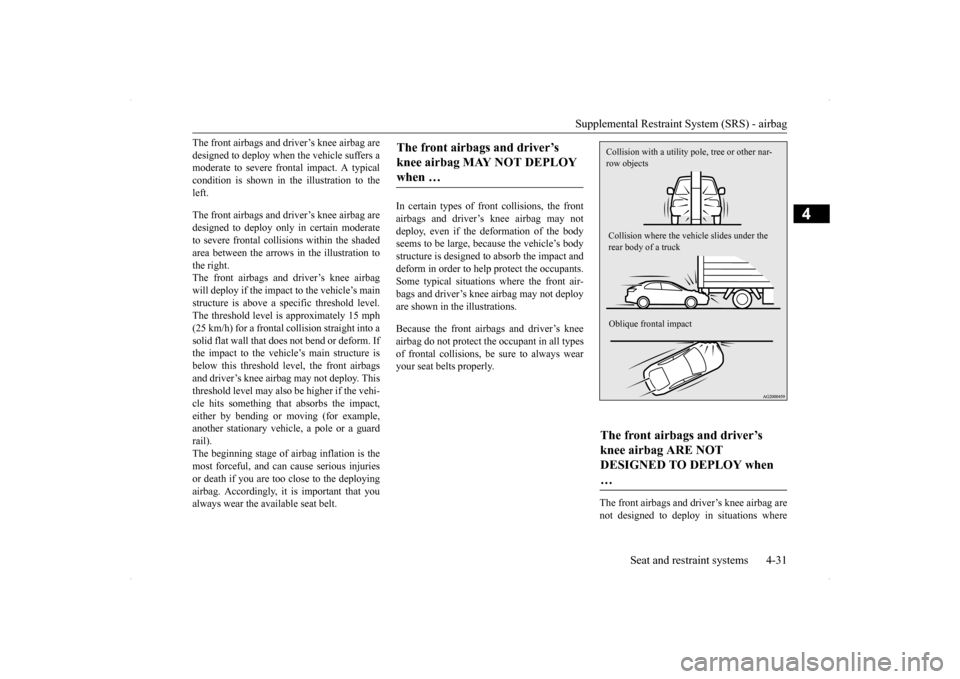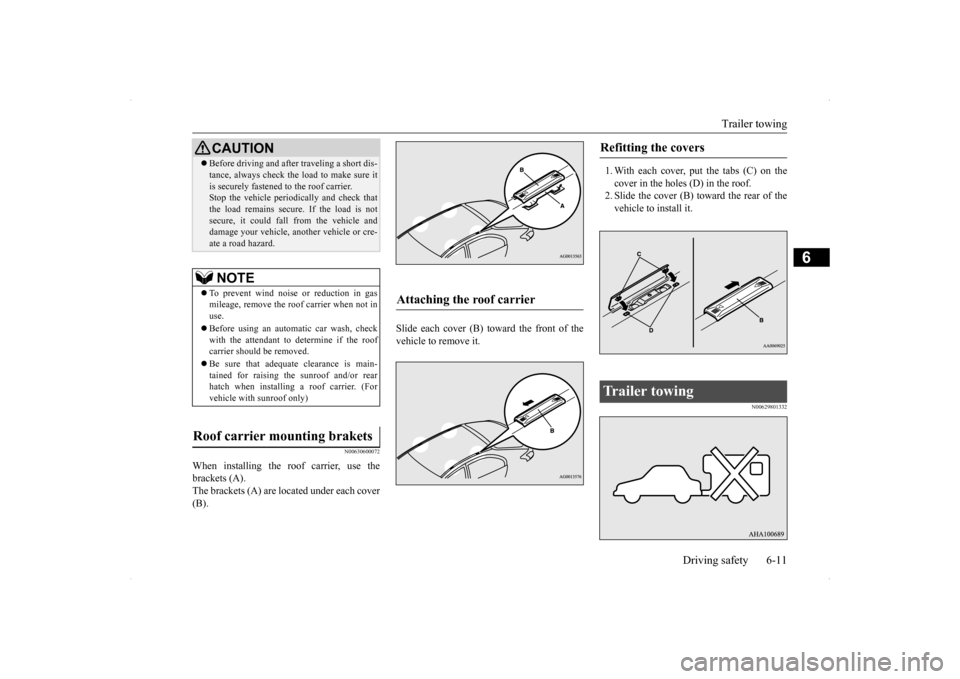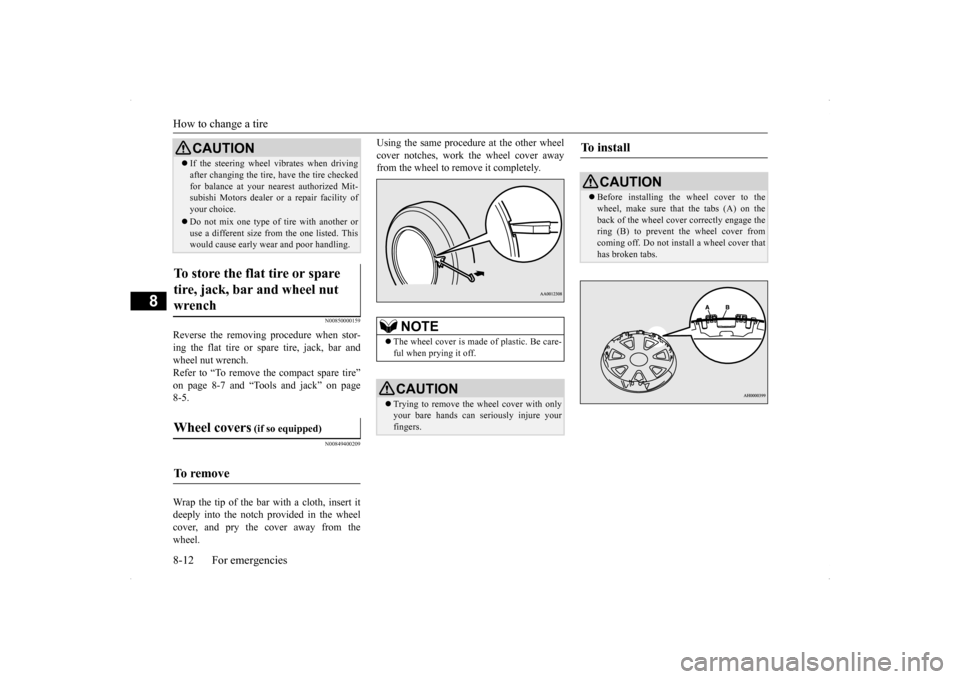ABS MITSUBISHI LANCER SPORTBACK 2014 8.G Owners Manual
[x] Cancel search | Manufacturer: MITSUBISHI, Model Year: 2014, Model line: LANCER SPORTBACK, Model: MITSUBISHI LANCER SPORTBACK 2014 8.GPages: 422, PDF Size: 55.11 MB
Page 58 of 422

Supplemental Restraint System (SRS) - airbag
Seat and restraint systems 4-31
4
The front airbags and driver’s knee airbag are designed to deploy when the vehicle suffers a moderate to severe frontal impact. A typical condition is shown in th
e illustration to the
left. The front airbags and driver’s knee airbag are designed to deploy only in certain moderate to severe frontal collisions within the shadedarea between the arrows in the illustration to the right. The front airbags and driver’s knee airbagwill deploy if the impact to the vehicle’s mainstructure is above a specific threshold level. The threshold level is approximately 15 mph (25 km/h) for a frontal collision straight into asolid flat wall that does not bend or deform. If the impact to the vehicle’s main structure is below this threshold level, the front airbagsand driver’s knee airbag may not deploy. This threshold level may also be higher if the vehi- cle hits something that absorbs the impact,either by bending or moving (for example, another stationary vehicle, a pole or a guard rail).The beginning stage of airbag inflation is the most forceful, and can cause serious injuries or death if you are too
close to the deploying
airbag. Accordingly, it is important that you always wear the available seat belt.
In certain types of front collisions, the front airbags and driver’s knee airbag may not deploy, even if the deformation of the body seems to be large, because the vehicle’s bodystructure is designed to absorb the impact and deform in order to help protect the occupants. Some typical situations where the front air-bags and driver’s knee airbag may not deployare shown in the illustrations. Because the front airbags and driver’s knee airbag do not protect the occupant in all types of frontal collisions, be sure to always wearyour seat belts properly.
The front airbags and driver’s knee airbag are not designed to deploy in situations where
The front airbags and driver’s knee airbag MAY NOT DEPLOY when …
The front airbags and driver’s knee airbag ARE NOT DESIGNED TO DEPLOY when … Collision with a utility pol
e, tree or other nar-
row objects Collision where the vehi
cle slides under the
rear body of a truck Oblique frontal impact
BK0200700US.bo
ok 31 ページ 2013年2月15日 金曜日 午後12時17分
Page 63 of 422

Supplemental Restraint System (SRS) - airbag 4-36 Seat and restraint systems
4
N00408200510
A side airbag and curtain airbag are designed to deploy when the vehicle suffers a moderateto severe side impact to the middle of the pas- senger compartment. The typical situation is shown in the illustra-tion. The seat belts in your vehicle are your pri- mary means of protection in an accident. The SRS (Supplemental Restraint System) sideairbags and curtain airbags are designed to provide additional protection. Therefore, for
your safety and the safety of all occupants, be sure to always wear your seat belts properly. In certain types of side collisions, the side air- bag and curtain airbag may not deploy, evenif the deformation of the body seems to be large, because the vehicle’s body structure is designed to absorb the impact and to deformin order to help protect the occupants. Sometypical situations where the side airbag and curtain airbag may not deploy are shown in the illustrations. Because the side airbags and curtain airbags do not protect the occupant in all types of side collisions, be sure to always wear your seat belts properly.
Deployment of side airbag and curtain airbag The side airbag and curtain airbag ARE DESIGNED TO DEPLOY when … Moderate to severe impact to the middle of the vehicle body’s side structure
The side airbag and curtain airbag MAY NOT DEPLOY when …
Side impact in an area away from the passen- ger compartment Motorcycle or other simil
ar small vehicle colli-
sion with the side of vehicle Collision with a utility pol
e, tree or other nar-
row object
BK0200700US.bo
ok 36 ページ 2013年2月15日 金曜日 午後12時17分
Page 270 of 422

Trailer towing
Driving safety 6-11
6
N00630600072
When installing the roof carrier, use the brackets (A). The brackets (A) are located under each cover(B).
Slide each cover (B) toward the front of the vehicle to remove it.
1. With each cover, put the tabs (C) on the cover in the holes (D) in the roof. 2. Slide the cover (B) toward the rear of thevehicle to install it.
N00629801332
Before driving and after traveling a short dis- tance, always check the load to make sure it is securely fastened to the roof carrier. Stop the vehicle periodically and check that the load remains secure. If the load is notsecure, it could fall from the vehicle and damage your vehicle, another vehicle or cre- ate a road hazard.NOTE
To prevent wind noise or reduction in gas mileage, remove the roof carrier when not in use. Before using an automatic car wash, check with the attendant to determine if the roof carrier should be removed. Be sure that adequate clearance is main- tained for raising the sunroof and/or rearhatch when installing a roof carrier. (For vehicle with sunroof only)
Roof carrier mounting brakets
CAUTION
Attaching the roof carrier
Refitting the covers Trailer towing
BK0200700US.bo
ok 11 ページ 2013年2月15日 金曜日 午後12時17分
Page 345 of 422

How to change a tire 8-12 For emergencies
8
N00850000159
Reverse the removing procedure when stor- ing the flat tire or spare tire, jack, bar and wheel nut wrench. Refer to “To remove the compact spare tire”on page 8-7 and “Tools and jack” on page 8-5.
N00849400209
Wrap the tip of the bar with a cloth, insert it deeply into the notch provided in the wheelcover, and pry the cover away from the wheel.
Using the same procedure at the other wheel cover notches, work the wheel cover away from the wheel to remove it completely.
If the steering wheel vibrates when driving after changing the tire, have the tire checked for balance at your nearest authorized Mit- subishi Motors dealer or a repair facility of your choice. Do not mix one type of tire with another or use a different size from the one listed. Thiswould cause early wear
and poor handling.
To store the flat tire or spare tire, jack, bar and wheel nut wrench Wheel covers
(if so equipped)
To remove
CAUTION
NOTE
The wheel cover is made of plastic. Be care- ful when prying it off. CAUTION Trying to remove the wheel cover with only your bare hands can seriously injure your fingers.
To i n s t a l l
CAUTION Before installing the wheel cover to the wheel, make sure that the tabs (A) on the back of the wheel cover correctly engage the ring (B) to prevent the wheel cover fromcoming off. Do not install a wheel cover that has broken tabs.
BK0200700US.bo
ok 12 ページ 2013年2月15日 金曜日 午後12時17分
Page 348 of 422

Operation under adverse driving conditions
For emergencies 8-15
8
lever in the “N” (NEUTRAL) position (CVT).
N00837200705
If your vehicle becomes stuck in snow, sand, or mud, it can often be moved by a rocking motion. Rock your vehicle back and forth tofree it. Do not rev the engine or spin the wheels. Constant efforts to free a stuck vehicle cancause overheating and transaxle failure. Let the engine idle for a few minutes to cool the transaxle before trying again.If your vehicle is still stuck after several rock- ing attempts, call for a commercial tow truck service.
When driving on a road covered with snow or ice, use snow tires. Tire chains cannot be used on your vehicle. Theremay be state or local regulations about using snow tires. Always check the regu- lations in your local area before usingthem. Refer to the section entitled “Snow tires” on page 9-23 and “Tire chains” on page 9-24. Drive slowly. Do not make sudden starts or stops, sharp turns, or slam on the brakes. Allow extra distance between your vehi- cle and the vehicle in front of you, and avoid sudden braking. If a skid occurs when the accelerator pedal is depressed, take your foot off the pedal. Steer gently in the direction of the skid. Your vehicle is equipped with an anti-lock braking system (ABS). Hold the brake pedal down firmly and keep it depressed.Do not pump the brake pedal which will result in reduced braking performance.
WA R N I N G To prevent entry of exhaust gas from the towing vehicle, set the selection switch to the recirculation position.
Operation under adverse driving conditions If your vehicle becomes stuck in sand, mud or snow
WA R N I N G When trying to rock your vehicle out of a stuck position, make sure that there are no people nearby. The rocking motion can make your vehicle suddenly lurch forward or backward, and injure any bystanders.
On wet roads
CAUTION Avoid flooded roads. Water is often deeper than it looks, and you could be seriously hurt by driving into flood water. When driving in rain, on water-covered roads, or through a car wash, water could getinto the brake discs and make them fail tem- porarily. In such cases
, lightly press the
brake pedal to see if they are working prop-erly. If they are not, press the pedal lightly several times while driving to dry the brake pads or linings, then check them again. When driving in rain, a layer of water may form between the tires and the road surface(aquaplaning). This loosens your tires’ grip on the road, making it difficult to steer or brake properly. When driving on a wet road:• Drive your vehicle at a safe speed.• Do not drive on worn tires.• Always keep the tires at the correct infla- tion pressures.
On snowy or icy roads
BK0200700US.bo
ok 15 ページ 2013年2月15日 金曜日 午後12時17分
Page 367 of 422

Tires 9-18 Vehicle care and maintenance
9
Sidewall: portion of a tire between the tread and bead. Section width: the linear distance between the exteriors of the sidewalls of aninflated tire, excluding elevations due to labeling, decoration, or protective bands. Bead: the part of the tire that is made of steel wires, wrapped or reinforced by ply cords and that is shaped to fit the rim. Ply: a layer of rubber-coated parallel cords. Cord: the strands forming the plies in the tire. Rim: a metal support for a tire or a tire and tube assembly upon which the tire beads are seated. Rim diameter: nominal diameter of the bead seat. Groove: the space between two adjacent tread ribs.
EXAMPLE:P215/65R15Tire Markings Size Designation P
Passenger car tire size based on U.S.A. design standards
215
Section width in millimeters (mm.)
65
Aspect ratio in percent (%) Ratio of section height to sec- tion width of tire.
R
Construction code •“R” means radial construc- tion. •“D” means diagonal or biasconstruction.
15 Rim diameter in inches (in)
NOTE
European/Japanese metric tire sizing is based on European/Jap- anese design standards. Tiresdesigned to these standards have the tire size molded into the sidewall beginning with the sec-tion width. The letter “P” is absent from this tire size desig- nation. Example: 215/65R1596H.
BK0200700US.bo
ok 18 ページ 2013年2月15日 金曜日 午後12時17分
Page 396 of 422

Replacement of light bulbs
Vehicle care and maintenance 9-47
9
N00944100329
1. Insert a screwdriver into the notch of the light assembly and pry gently to removethe lens.
2. While holding down
the tab (A), pull out
the bulb. 3. To install the bulb, perform the removal steps in reverse.
N00950000075
1. Insert a screwdriver into the notch of thelight assembly and pry gently to removethe lens. 2. Remove the bulb by pulling it out.
Dome light (rear)
(if so equipped)
NOTE
Wrap a cloth around the tip of the screw- driver to keep from scratching the lens.
NOTE
Before replacing the bulb, put the dome light (rear) switch into the “OFF” position. When mounting the lens, align the tabs (B) with the holes on
the vehicle body.
Cargo room light
NOTE
Wrap a cloth around the tip of the screw- driver to keep from scratching the lens.
BK0200700US.bo
ok 47 ページ 2013年2月15日 金曜日 午後12時17分
Page 405 of 422

Important facts to know in case of an accident 10-4 Customer assistance/Reporting Safety Defects
10
call (671)649-3673 or write to: To contact Triple J Motors call (670)234-7133 or write to: To contact Pacific Marketing Inc. call 684(699)9140 or write to:
N01047300229
We hope you will never be involved in an accident, but there is always that potential danger. So, please be sure to buckle up and drive safely. Remain calm. Check for injuries. Report all injuries to the police, and, if necessary, call for anambulance. Record all the details of the accident. This will provide you with accurate records ofthe accident for discussions with your insurance company and other persons who may be acting on your behalf.
Understand your repair estimate before approving repairs. Choosing the repair shop and the brands of parts that they use on your vehicle is your decision. Ask for genuine Mitsubishi Motors parts. Many times, to save money, your insur- ance company will recommend imitationparts that do not meet the original specifi-cations of fit, finish, corrosion resistance or workmanship.
The strength and integrity built into your Mit- subishi vehicle is the result of a specificdesign referred to as “Energy Management”. Individual body parts are designed to act as one unit in the event of an accident. Shockwaves are absorbed by protective panels or are channeled around the passenger compart- ment. This important feature is possiblebecause high tensile steel is used in Mitsubi- shi Motors panels and structural parts, some- thing that cannot be guaranteed by themanufacturers of imitation parts. All Genuine Mitsubishi Motors body panels and support
Triple J Enterprises, Inc. P.O. Box 6066 TA M U N I N G GUAM 96931
For vehicles sold in Saipan
Triple J Motors P.O. Box 500487 SAIPAN, MP96950-0487
For vehicles sold in American Samoa
Pacific Marketing, Inc. P.O. Box 698PA G O PA G O , AMERICAN SAMOA AS, 96799Important facts to know in case of an accident In the event of an accident
Key information to discuss with your insurance company Mitsubishi Motors built-in pro- tection
BK0200700US.bo
ok 4 ページ 2013年2月15日 金曜日 午後12時17分